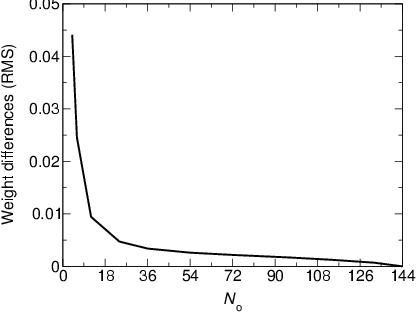
Click on the image to see a PDF version (for zooming in)
Fig. 15.8. Accuracy of the final GLISSOM map as a function of the
initial network size. Each point shows the RMS difference between
the final values of the corresponding weights of each neuron in two
networks: a 144 × 144 LISSOM map, and a GLISSOM network with an
initial size shown on the x-axis and a final size of 144 × 144. Both
maps were trained on the same stream of oriented inputs. The GLISSOM
maps starting at most as large as N = 96 were based on four scaling
steps, whereas the three larger starting points included fewer steps:
N = 114 had one step at iteration 6500, N = 132 had one step at
iteration 1000, and there were no scaling steps for N = 144. Low
values of RMS difference indicate that the corresponding neurons in
each map developed very similar weight patterns. The RMS difference
drops quickly as larger initial networks are employed, becoming
negligible above 36 × 36. As was described in Section 15.2.3, this
lower bound is determined by rEf, the minimum
size of the excitatory radius.
|